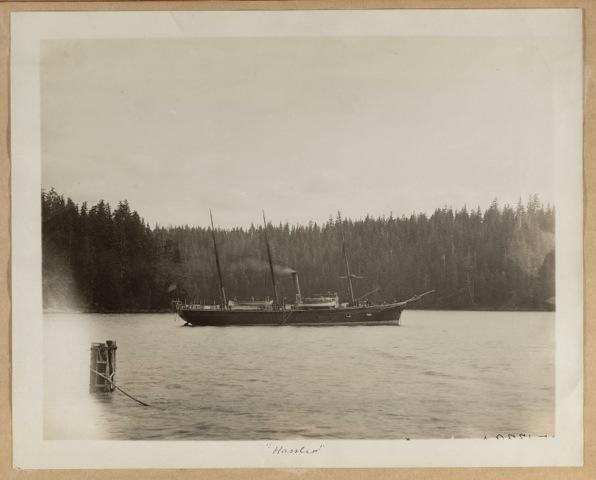[This post is part of a series on the archives of the 1871-1872 Hassler expedition, written by Bruno Costelini, Science without Borders intern at the Ernst Mayr Library]
Things did not look too good at the outset of the Hassler deep-sea dredging expedition. After leaving the Charlestown Navy Yard on the afternoon of December 4th, 1871, the ship had to anchor in Georges Island because of strong winds coming from S.W. accompanied by ominous clouds that looked “black and angry.” Starting again the next morning amidst the same weather, the thermometer at 20 degrees and ice “up about the bow on the rigging and mast,” a “cable broke loose and went down against the port stateroom doors” and almost all the party was seasick. [1]
The ship didn’t make much further, resting at Holmes Hole (Vineyard Haven) for a couple of days.

The Hassler was a brand new 151 feet, 350 tons steamer that combined a 125-horse-power engine with a three-mast-schooner sailing rig. Built in Camden, NJ, it was commissioned by the U.S. Coast Survey, then presided by Benjamin Peirce, for a dredging expedition around South America on its way to California. Peirce invited his friend and one of the foremost naturalists at the time Harvard Professor (and founder of the Museum of Comparative Zoology) Louis Agassiz to lead the scientific party and Agassiz raised enough money to bring along his wife and a few others, among them his student James Henry Blake, the expedition’s artist.[2]
Back to sea on December 7th, things didn’t seem to have improved much as Blake notes:
Towards the last part of the night the wind increased and the sea from this wind accompanied by the swell from the strong preceding winds made the ship roll heavily, and nearly all on party were seasick and many of the crew felt somewhat so.
Although I was very seasick I stood my regular watch during the day but did not eat at the table for several meals.
His watch as a member of the scientific party consisted in taking down the temperature and specific gravity of the water (a measure of its density). The attention to these parameters show a serious program of data collection was being carried out by the expedition along with its sounding and dredging efforts. Throughout the voyage Blake would also note on his journals the air temperature and geographical coordinates.

The next day the Hassler’s luck took a turn for the worse as she would experience perhaps her worst moments in this first leg of the trip:
My watch came from 4 to 8 in the morning and I think I divided the time nearly equally between walking the deck and vomiting. Things were thrown about in the ship generally, and the ward room looked as if there had been a war during the night. I was suddenly surprised and consequently slept somewhat disturbed by the capsizing of my water pitcher that sat on my bureau in a rack at the head of my bunk, and the contents coming into my face and on my pillow.
By the 10th, the vessel had reached the warmer waters of the Gulf Stream but the party had not yet “wholly recovered from our seasickness yet feel quite thankful that we are not so bad as we were.” On the next day, however, they were already feeling much better, so much so that Blake could brag about the weather and of spending time on the deck until the evening
witnessing the beautiful golden sunset and enjoying the warm air. We have the water and air about the same temperature, 66 ½ and I have been in my slippers and signing for a straw hat all day. It hardly seems possible that two days ago our ship was covered with ice and the ther[mometer] at 18° above 0, and that now my friends at home are shivering with their coats on.

The Hassler would only reach its next port on the 15th but the worse had already passed. The days in between were spent collecting seaweed and associated faunae as they travelled on the Sargasso Sea towards St. Thomas, while studying their findings under Prof. Agassiz’s direction.
[2] Irmscher, Christopher. Louis Agassiz: Creator of American Science. Boston: Houghton Mifflin Harcourt, 2013. 311-316

